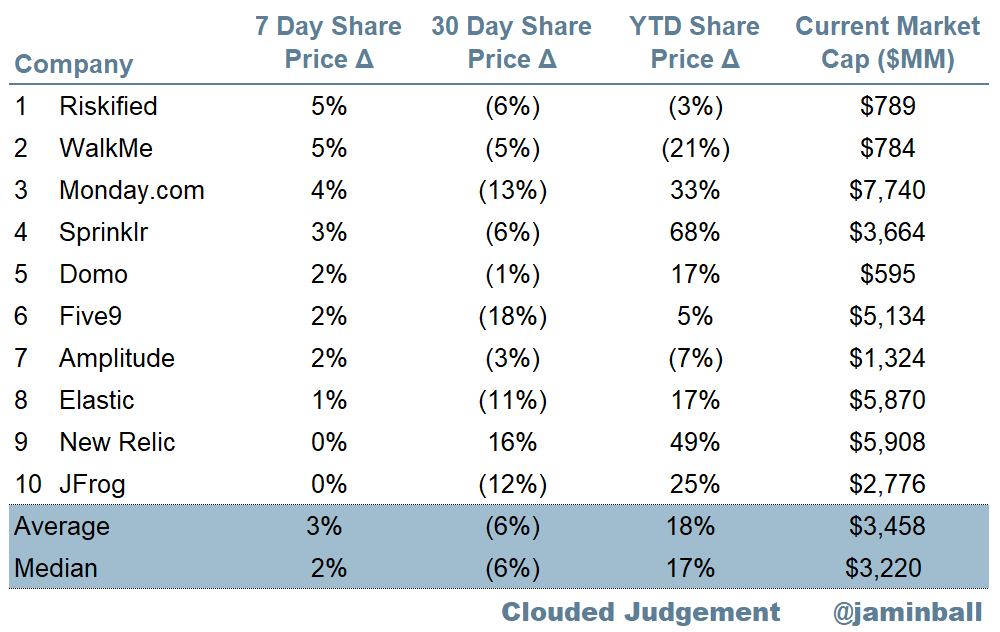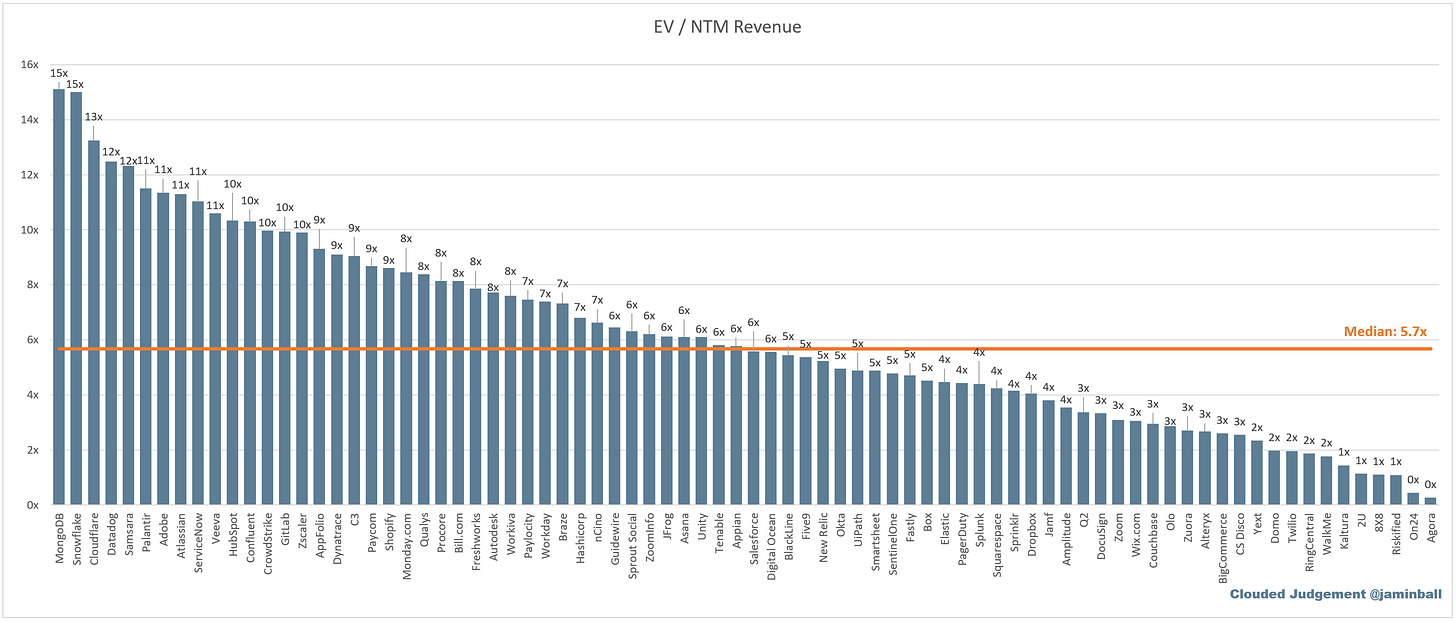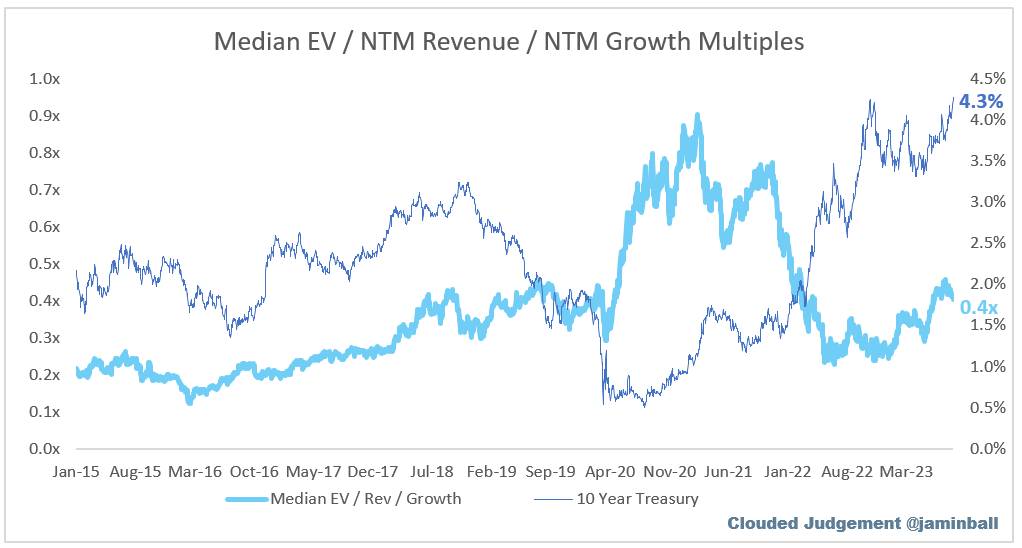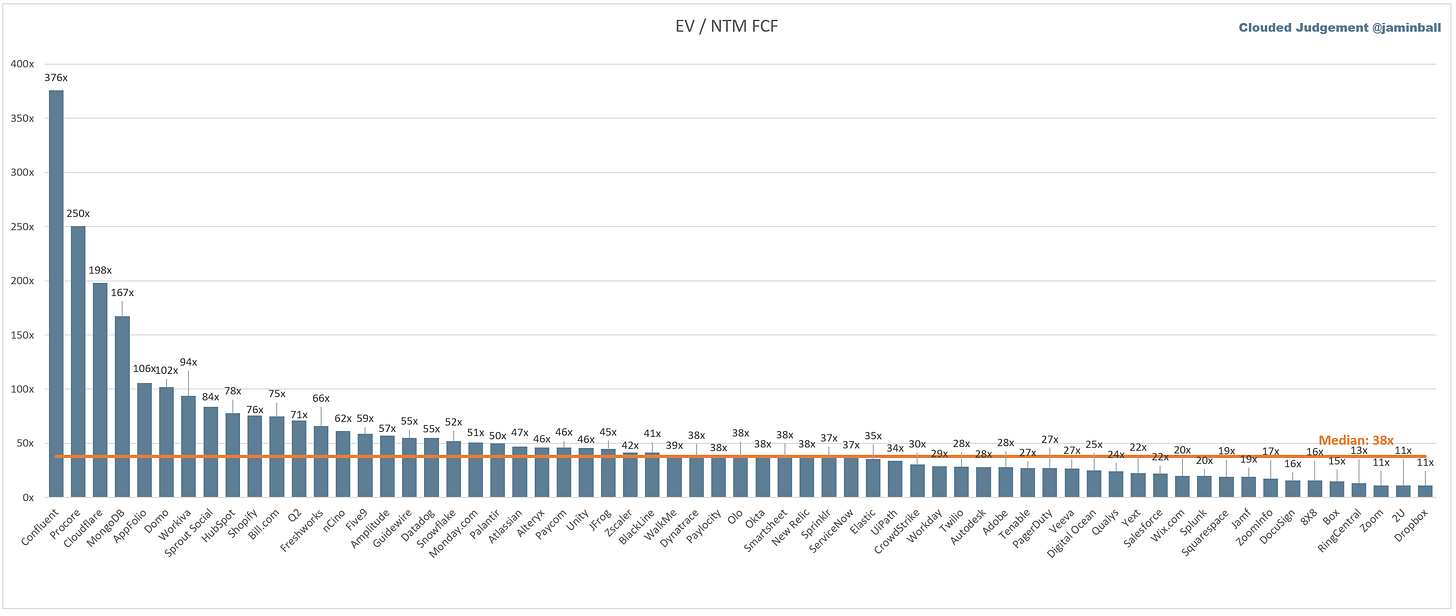Every week I’ll provide updates on the latest trends in cloud software companies. Follow along to stay up to date!
Q2 Earnings Check In
We’re now about halfway through Q2 earnings season (companies with June quarter ends have reported, and we’ll get companies with July quarter ends reporting next week). I wanted to do a quick review of results so far to see what the data is showing us.
Before some Q2 data, some quick market analysis. I think there are broadly 3 scenarios for the economy:
Economic growth stays strong, inflation falls, rates fall (if inflation ticks down to 2% next year we won’t need rates at 5%+)
Economic growth deteriorates (negative GDP growth / recession), inflation falls, rates fall
Economic growth stays strong, inflation stays sticky, rates stay higher for longer
In May / June / July the market became enamored with scenario 1 as the base case. Inflation was coming down, economy was growing well, and labor markets were incredibly tight. Scenario 1 is the soft landing camp. This is the one scenario above that is quite good for equities. However, more recently the sentiment has shifted. The market is betting that the likelihood of scenario 2 and 3 have gone up.
Scenario 2 is the recession scenario. Obviously, this would be bad for equities. Even through rates would be cut (tailwind for valuations), the headwinds to business performance from a recession would overwhelm the rate tailwind. And there are many smart people out there pointing to leading indicators of an impending recession. China’s economy is in trouble and they just printed deflation. Mortgages are 8%+. Student debt repayments start soon. Excess savings are drained. All of this adding up, making an incoming recession seem more likely than what it was a few months back.
Scenario 3 is the “economy is stable but inflation stays sticky” scenario. The 10Y has risen to 4.3% which is up from 3.4% in early May. This is the highest the 10Y has been since pre Global Financial Crisis. Said another way, the market is now discounting higher rates for longer as more of a base case.
As the market continues to discount scenario 2 and 3 as increasingly likely we’ll continue to see pressure on equities.
Now let’s look at some Q2 software earnings data starting with net new ARR trends. If we look at new new ARR YoY growth, you’ll see that it actually ticked up a bit in Q2
We’re also on track to add a lot more of aggregate new new ARR in Q2 than Q1. The below chart shows Q2 to date, and we still have ~30 companies left to report. So the Q2 bar will undoubtedly be larger than the Q1 bar once the quarter ends
However, when we break the net new ARR YoY growth down into growth cohorts (below), you’ll see that the high growth cohort of companies actually dipped lower in Q2 vs Q1 YoY ARR Growth, while the low and mid growth cohorts YoY growth rate of net new ARR went up
Looking at a few other charts you’ll see that the revenue growth rate ticked down (but not by as much as recent quarters).
FCF margins still remain strong
And net retention continues to drop quite dramatically
As a reminder - the figures for Q2 only include about half the companies that are included in prior quarters (since we haven’t had everyone report yet)
Quarterly Reports Summary
Top 10 EV / NTM Revenue Multiples
Top 10 Weekly Share Price Movement
Update on Multiples
SaaS businesses are generally valued on a multiple of their revenue - in most cases the projected revenue for the next 12 months. Revenue multiples are a shorthand valuation framework. Given most software companies are not profitable, or not generating meaningful FCF, it’s the only metric to compare the entire industry against. Even a DCF is riddled with long term assumptions. The promise of SaaS is that growth in the early years leads to profits in the mature years. Multiples shown below are calculated by taking the Enterprise Value (market cap + debt - cash) / NTM revenue.
Overall Stats:
Overall Median: 5.7x
Top 5 Median: 13.2x
10Y: 4.3%
Bucketed by Growth. In the buckets below I consider high growth >30% projected NTM growth, mid growth 15%-30% and low growth <15%
High Growth Median: 10.0x
Mid Growth Median: 8.1x
Low Growth Median: 3.5x
EV / NTM Rev / NTM Growth
The below chart shows the EV / NTM revenue multiple divided by NTM consensus growth expectations. So a company trading at 20x NTM revenue that is projected to grow 100% would be trading at 0.2x. The goal of this graph is to show how relatively cheap / expensive each stock is relative to their growth expectations
EV / NTM FCF
Companies with negative NTM FCF are not listed on the chart
Scatter Plot of EV / NTM Rev Multiple vs NTM Rev Growth
How correlated is growth to valuation multiple?
Operating Metrics
Median NTM growth rate: 15%
Median LTM growth rate: 23%
Median Gross Margin: 75%
Median Operating Margin (18%)
Median FCF Margin: 6%
Median Net Retention: 115%
Median CAC Payback: 47 months
Median S&M % Revenue: 44%
Median R&D % Revenue: 27%
Median G&A % Revenue: 17%
Comps Output
Rule of 40 shows rev growth + FCF margin (both LTM and NTM for growth + margins). FCF calculated as Cash Flow from Operations - Capital Expenditures
GM Adjusted Payback is calculated as: (Previous Q S&M) / (Net New ARR in Q x Gross Margin) x 12 . It shows the number of months it takes for a SaaS business to payback their fully burdened CAC on a gross profit basis. Most public companies don’t report net new ARR, so I’m taking an implied ARR metric (quarterly subscription revenue x 4). Net new ARR is simply the ARR of the current quarter, minus the ARR of the previous quarter. Companies that do not disclose subscription rev have been left out of the analysis and are listed as NA.
This post and the information presented are intended for informational purposes only. The views expressed herein are the author’s alone and do not constitute an offer to sell, or a recommendation to purchase, or a solicitation of an offer to buy, any security, nor a recommendation for any investment product or service. While certain information contained herein has been obtained from sources believed to be reliable, neither the author nor any of his employers or their affiliates have independently verified this information, and its accuracy and completeness cannot be guaranteed. Accordingly, no representation or warranty, express or implied, is made as to, and no reliance should be placed on, the fairness, accuracy, timeliness or completeness of this information. The author and all employers and their affiliated persons assume no liability for this information and no obligation to update the information or analysis contained herein in the future.






















